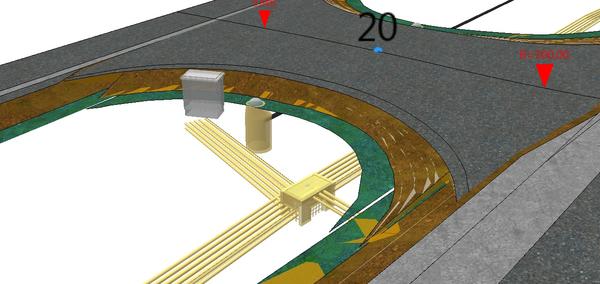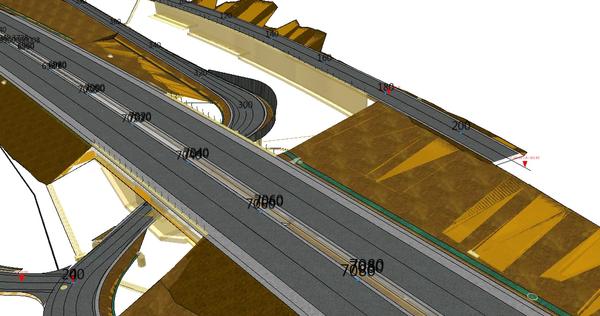Rambøll sets the standard for multi-discipline infrastructure design

To meet increasing demands for cost-effective and sustainable model deliveries Rambøll aims to set the industry standard for multi-discipline design of infrastructure. Vianova's new BIM tools are being used to obtain tight collaboration between the various disciplines. Rambøll Drammen is the office leading the development.
“Our objective is to be both innovative and offensive”, says Christian Thorstensen, head of water and sewer design in multidiscipline projects at Rambøll. “It is important to be proactive in order to stay in the front.”
Leading
Rambøll is a leading Nordic consulting company, covering segments like transport infrastructure, building, architecture, environment, energy, oil and gas, and business consulting. The company offers consulting in the entire value chain. In Norway the company comprises approximately 1,500 employees in 21 offices. The Drammen office counts approx. 150 people and is fully interdisciplinary.
“Over the last year we have started all new infrastructure projects in NovapointDCM”, continues Thorstensen, “just water and sewer projects, as well as multi-discipline projects”.
Multi-discipline project
One good example of the latter is the E6 Biri-Vingrom road project along lake Mjøsa. Largely a “mid-road dividing” project, but it also includes a 2 km long four-lane overtaking stretch. Rambøll has run this project from the municipal zoning plan to the construction plan.

“We have run full multidisciplinary design, both road, water and sewer, electrical, structures and landscape. The zoning was done in Novapoint 18, but when NovapointDCM 19 became a reality we decided to do the construction plan in Vianova's new BIM technology”, he says.
P. t. the status of the construction process is that all water and sewer is built, whilst the rest is not quite done yet. Everything has more or less elapsed "according to the book" describes Thorstensen:
From WS model to construction
“After having delivered our completed WS model to Isachsen, the contractor, we heard nothing from them. They received the discipline model as sole survey data, all according to the Norwegian road authority´s design manual V770. Eventually I had to contact the project manager to check if they had any questions about our delivery. My surprise was therefore great when he replied that the bulk of the WS job was already done. Everything had been in perfect order.”
Challenges are solved
“Adopting new technology in a "live" project always involves a risk”, he emphasizes. “That's just how it is with new software. We were therefore well prepared for some challenges in moving to NovapointDCM 19 and QuadriDCM.
“Some bugs and errors have popped up in these programs as well, but we have had very good communication with Vianova Systems, so we have always found a work-around.”
After a short start-up course at Vianova, where all the discipline coordinators participated, Rambøll has since then only carried out internal training.
Easy to learn
“Our employees learn quickly. NovapointDCM 19 is considerably more intuitive than 18, so we have largely learned by working with the tools. In addition, we have received great assistance from Vianova to optimize the Quadri server and the usage of this. During the project we have also received frequent program updates. 19 has evolved very much since its first release”, praises Christian Thorstensen.
“The biggest difference in transitioning from Novapoint 18 to 19 has been the use of NovapointDCM Base and the terrain model in that regard. You get a completely different “connection” to the data in 19. Working with the WS and road application, are relatively similar. It's the Base application, the model data and the collaboration through Quadri that represent the biggest change.”
“Usually it is a tough job to change working practices. The new BIM tools contribute strongly to change old habits”, he says.
Continuous 3D presentation
“NovapointDCM 19 provides a visual control that is invaluable. Especially for junior personnel this is very useful. You get a much better feeling of the design and what you are designing. All disciplines are continuously updated in the QuadriDCM model. You see visually how the ongoing design changes according to the updates.
“Fos us WS engineers, not being road designers, NovapointDCM 19 provides a very good picture of what is being designed in a quick way. The contiuous 3D view is priceless. The 3D model is very useful for everyone that need insight into the design. We have our visualization packages as well, but they are much harder to work with, so they are not used as often anymore. The built-in 3D view covers most of our need”, says Thorstensen.
“Previously it used to be the road designers who had the ownership of the terrain model, but with NovapointDCM we all get a more equal relationship with the model, and what it is used for. And that is very positive. This contributes to much better cooperation and mutual understanding of the design data.”

Uncovers interdisciplinary errors
“Interdisciplinary the new tools also provide a quicker way to detect design conflicts. The threshold for self-controlling checking is much lower since the 3D view in Quadri is simple and continuous. You discover conflicts significantly faster, and it´s easier to bring them up. Moreover, when correcting something, you see right away if it gets right”, he points out.
“The use of Quadri itself has also been good, but not optimal yet, despite good help from Vianova Systems. But their development is fast moving forward. The performance has become significantly better.”
Added customer value
“We are now using NovapointDCM in all new WS projects, multi-discipline as well as not”, says Thorstensen. “Here in Drammen we are currently working on the 134 Mjøndalen-Hokksund project and a cycle path project in Drammen. Both fully multi-discipline.
”With QuadriDCM you get a very good tool for multi-discipline collaboration and control. As long as you work directly in Quadri it´s no additional work. And the gain in collaboration and quality is well worth. It has a great added value for customers that we are exploiting all the features of the tools”, concludes Christian Thorstensen.